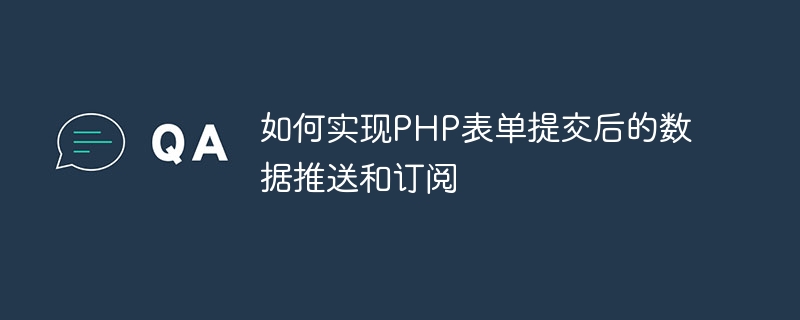

How to implement data push and subscription after PHP form submission
With the development of the Internet, data transmission has become more and more important. In website development, it is often necessary to submit data through forms and process and save this data. In some specific scenarios, we also hope to push this data to other applications or users in real time for subscription to achieve more functions. This article will introduce how to use PHP to implement data push and subscription after form submission, and give corresponding code examples.
There are usually two methods of data push: polling and long connection. In polling, the client periodically sends requests to the server to see if new data is available. In a long connection, the server actively pushes data to the client. Since long connections can push data in real time, long connections are more commonly used when implementing data push and subscription.
In PHP, we can use WebSocket technology to implement long connections. WebSocket is a protocol for full-duplex communication over a single TCP connection, which allows the server to actively push data to the client. In PHP, we can use the Ratchet library to simplify WebSocket development.
First, we need to set up a WebSocket server. You can use the following code example:
use RatchetMessageComponentInterface;
use RatchetConnectionInterface;
require dirname(__DIR__) . '/vendor/autoload.php';
class PushServer implements MessageComponentInterface
{
protected $clients;
public function __construct()
{
$this->clients = new SplObjectStorage;
}
public function onOpen(ConnectionInterface $conn)
{
echo "新连接({$conn->resourceId})加入
";
$this->clients->attach($conn);
}
public function onMessage(ConnectionInterface $from, $msg)
{
echo "收到来自({$from->resourceId})的消息:{$msg}
";
foreach ($this->clients as $client) {
$client->send($msg);
}
}
public function onClose(ConnectionInterface $conn)
{
echo "连接({$conn->resourceId})关闭
";
$this->clients->detach($conn);
}
public function onError(ConnectionInterface $conn, Exception $e)
{
echo "出现错误:{$e->getMessage()}
";
$conn->close();
}
}
$server = RatchetServerIoServer::factory(
new RatchetHttpHttpServer(
new RatchetWebSocketWsServer(
new PushServer()
)
),
8080
);
$server->run();
In the above code, we implemented a PushServer class to handle the connection, message delivery and other operations of the WebSocket server. Among them, the onOpen() method is called when a new connection is added, the onMessage() method is called when a message is received, the onClose() method is called when the connection is closed, and the onError() method is called when an error occurs. In the onMessage() method, we send the received message to all connected clients.
Next, we need to process the form submitted data in PHP and pass the data to the WebSocket server for push. You can use the following code example:
<?php
if ($_SERVER['REQUEST_METHOD'] === 'POST') {
// 处理表单提交的数据
$data = $_POST['data'];
// 将数据发送给WebSocket服务器
$client = new RatchetClientWebSocket('ws://localhost:8080');
$client->send($data);
$client->close();
}
?>
In the above code, we first obtain the data submitted by the form through $_POST['data'], and then use the WebSocket client provided by the Ratchet library to send the data to WebSocket server.
Through the above code examples, we have implemented the data push and subscription functions after the PHP form is submitted. When a user submits a form, the form data is received by the WebSocket server and pushed to all subscribed clients. In this way, other applications or users can obtain this data in real time and process it accordingly.
Of course, in actual applications, some other factors may need to be considered, such as security, stability, etc. But through the above code examples, you should be able to basically understand how to use PHP to implement data push and subscription after form submission. Hope this article helps you!
The above is the detailed content of How to implement data push and subscription after PHP form submission. For more information, please follow other related articles on the PHP Chinese website!